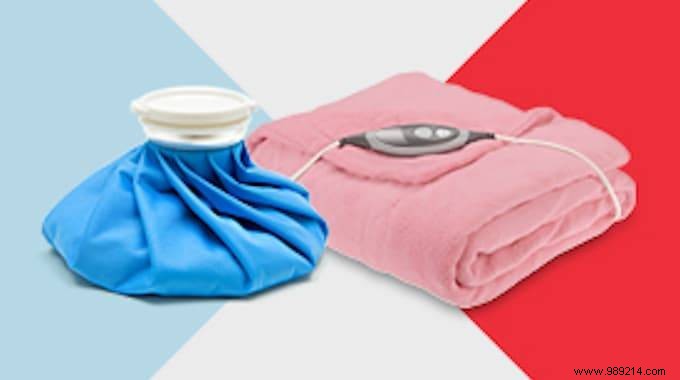
Unfortunately, physical pain is a part of life.
It can be a strained muscle, a torn ligament, back pain or even a headache.
And with age, we are also confronted with pain related to osteoarthritis!
Fortunately, cold and heat are our best allies to relieve pain.
The problem is that you don't always know whether it's better to take out the hot water bottle or the ice pack.
So, hot or cold? In this practical guide, our experts explain when and why it is necessary to apply cold or heat to your pains. Watch:

Q: Should you put cold or heat on arthritis ?
A: Warm.
Q: Should you put cold or hot for a gout attack ?
A: Cold.
Q: Should you put cold or heat for a violent headache ?
A: Cold.
Q: Should you put cold or heat for a muscle tear ?
A: Cold.
Q: Should you put cold or heat for a sprain ?
A: Warm.
Q: Should you put cold or heat for tendinitis ?
A: Cold.
Q: Should you put cold or heat for tendinosis ?
A: Warm.
“Ice packs feel cold, mean and unpleasant to us. Conversely, the heat gives a warm, comfortable and comforting sensation”, explains Dr. Anne Rex, a surgeon specializing in sports medicine.
“But it is the cold that prevails to treat acute pain, inflammation or swelling. Indeed, heat perpetuates the cycle of inflammation and can aggravate an injury.”
Physical therapist Carol Ferkovic-Mack, contributor to the medical journal Sports Health , adds:“Moist heat helps relax injured muscles before physical activity or a stretch. And apply cold after an activity will reduce the pain.”
“The cold of a reusable thermal mask or a moist compress on the forehead, eyes and temples lessens the throbbing pain of a migraine,” says neurologist Jennifer Kriegler.
Although cold is ideal, applying heat with a moistened washcloth can relax neck spasms, which also contribute to headaches.
It's the heat that wins for arthritis and injuries that last more than 6 weeks.
“Heat can also relieve the pain of patients with osteoarthritis, a chronic condition,” explains rheumatologist Linda Mileti. On the other hand, to treat acute gout attacks, Dr Mileti advises instead to apply cold.
There are several methods for applying cold or heat. As a general rule, experts recommend 20 min applications , followed by 20 min rest :
Ice bags: use an ice pack, like this one or even better make it a house. Otherwise, you can also use a bag of frozen peas or corn, ice cubes in a freezer bag or a reusable thermal gel pouch. You can continue to make applications beyond 48 hours, until the swelling, pain or inflammation disappears.
Refreshing massage: freeze water in a paper cup. Tear off the top of the cup to expose 3-5cm of ice. Massage the affected area until the pain is numb. This method is ideal for applying cold to the elbow, heel and other areas where it is difficult to apply an ice pack.
Reusable thermal mask: apply cold to your eyes with a reusable thermal mask, like this one. Alternatively, cover your forehead and temples with a cold water compress. To do this, use a small towel moistened with cold water.
Moist heat: relax in a bath, in the shower or in a jacuzzi. Use hot but not boiling water (33-37°C).
Self-heating patch: apply a self-heating patch, like this one, to the neck muscles. A convenient method when you're at work or on the go.
Heating pad: to avoid burns, remove your heating pad as soon as the heat becomes unpleasant.
Avoid paraffin treatments. Although they produce moist heat, they tend to overheat and can cause burns. In addition, the application of this type of treatment is complicated and the equipment is expensive.
"Be careful about areas with decreased sensation (for example, from neuropathy, diabetes, or Raynaud's syndrome)," Dr. Mack says. This is because extreme temperatures can damage the skin.
Not sure if it's safe to apply cold when you're suffering from a burning fever? According to Dr. Kriegler, “There is no harm in using cold to reduce fever.”
There you go, now you will be able to relieve your physical pain with cold or heat, without ever having any doubt !